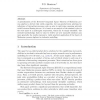107 search results - page 13 / 22 » Cooperative Agent Model Instantiation to Collective Robotics |
PRIMA
2004
Springer
14 years 2 months ago
2004
Springer
— Distributed computing systems are increasingly being created as self-organizing collections of many autonomous (human or software) agents cooperating as peers. Peer-to-peer coo...
ENTCS
2006
13 years 9 months ago
2006
A generalization of the Reversed Compound Agent Theorem of Markovian process algebra is derived that yields separable, but non-product-form solutions for collections of interactin...
IROS
2009
IEEE
14 years 3 months ago
2009
IEEE
— By combining a low-order model of forecast errors, the extended Kalman filter, and classical continuous optimization, we develop an integrated methodology for planning mobile ...
ATAL
2004
Springer
14 years 2 months ago
2004
Springer
Overhearing is gaining attention as a generic method for cooperative monitoring of distributed, open, multiagent systems. It involves monitoring the routine conversations of agent...
ATAL
2004
Springer
14 years 2 months ago
2004
Springer
Multi-agent research often borrows from biology, where remarkable examples of collective intelligence may be found. One interesting example is ant colonies’ use of pheromones as...

